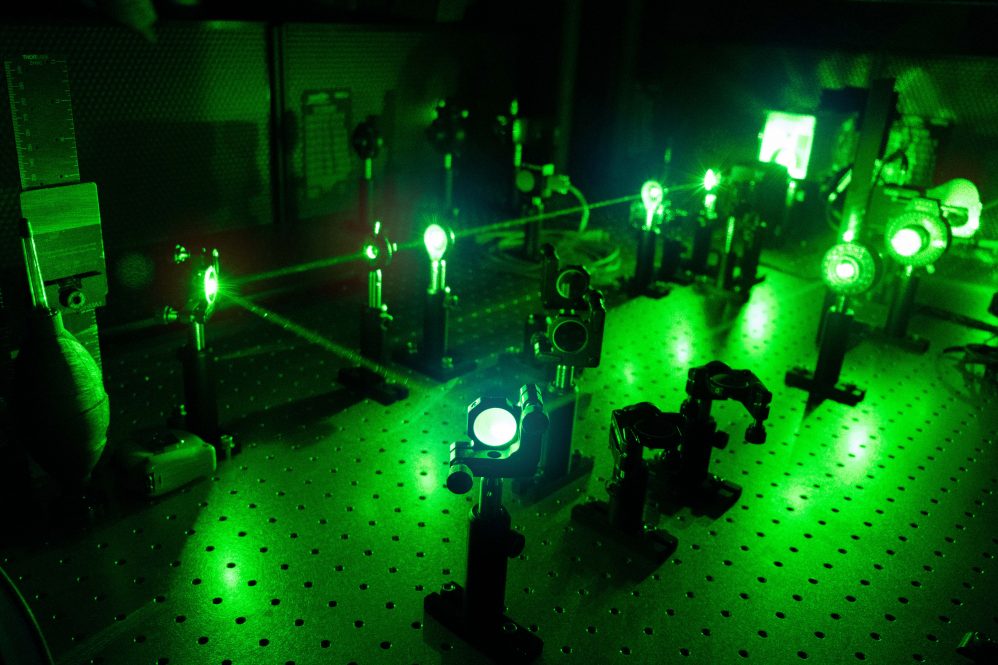The U.S. Department of Defense (DoD) has awarded four UConn scientists with high-profile grants to fund the acquisition of technology to bolster their research capabilities.
The highly competitive Defense University Research Instrumentation Program (DURIP), offered by the Air Force Office of Scientific Research (AFOSR), the Army Research Office (ARO), and the Office of Naval Research (ONR), funds cutting-edge research projects with potential to assist national defense.
Daniel McCarron: “Stimulated Optical Forces To Cool and Trap CH Radicals” (AFOSR)
McCarron, a physics professor, received a grant from the Air Force Office of Scientific Research for his work analyzing the quantum mechanical behavior of a simple hydrocarbon molecule: CH, or methylidyne. A highly reactive gas, methylidyne is abundant in the interstellar medium, and its simple composition promises to allow researchers to study the role of quantum mechanics within organic chemistry.
In order to expose the quantum nature of these molecules, McCarron has devised a way to cool them down to a millionth of a degree above absolute zero using laser light. At such a low temperature, “quantum effects are amplified and can reveal themselves in the lab,” he says.
“You don’t really get that in a beaker at room temperature – things just happen too quickly and too chaotically.”
The AFOSR is funding the purchase of a high-powered laser to assist in slowing down beams of CH radicals from about 100 meters per second to a more stationary several centimeters per second. This laser-cooling and trapping technology will allow McCarron to amplify and better study the quantum behavior of this organic molecule, with an eye toward furthering scientific knowledge about the role of quantum mechanics in chemical reactions in general—a field where successful research has been scarce.
“We don’t really know what role quantum mechanics plays in chemical reactions yet,” McCarron says. “Once we have an improved understanding here, there will likely be a wide range of applications,” from pharmaceuticals to other organic chemistry technologies.
Naba Karan: “Thermal Characterization Test Instrument for Lithium‐Ion Battery Safety Evaluation for Advanced Marine Technologies” (ONR)
Lithium-ion (Li-ion) batteries are one of the most common rechargeable energy storage technologies on the market. As a rule, they are quite safe under normal operating conditions, powerful, and scalable, from smartphones to electric cars. But given the number of Li-ion batteries produced around the world, their relatively small failure rate has still resulted in some high-profile stories of Li-ion batteries going into thermal runaway – an event when a battery catches fire, explodes, and releases toxic gases.
Karan, an assistant research professor at the Center for Clean Energy Engineering (C2E2) in the School of Engineering, isn’t surprised.
“You can think of them as bombs,” he says, noting the high quantity of chemical energy contained within Li-ion batteries. And he’s looking to blow them up—on purpose.
With funds from the Office of Naval Research, Karan is constructing a facility at UConn that will explode the batteries in a controlled environment to determine critical safety parameters needed for designing advanced engineering protocols to mitigate thermal runaway events. In a military context, this information will help operators of machinery that depends on these high-powered batteries, such as submarines, determine when internal battery temperatures are exceeding safety thresholds. Most crucially, it will allow them to avoid catastrophic failure by diverting some of this heat.
The equipment will be able to analyze thermal characteristics of all types of energy storage technologies, not only Li-Ion batteries. Since it will be one of the only such facilities in the northeast region, Karan anticipates a high degree of interest and collaboration from other universities and companies looking into studying the safety characteristics of existing and emerging battery chemistries.
Volkan Ortalan: “Multimodal Ultrafast Electron Microscopy and Femtosecond Spectroscopy in Materials for Extreme Environments” (AFOSR)
“Nanotechnology is the science of understanding and controlling matter at extremely small dimensions, ranging from 1 to 100 nanometers (nm),” says Ortalan, an associate professor of materials science and engineering. “For comparison, a fingernail grows about 1 nm in a second.”
Because of their small size, nanomaterials demonstrate unusual properties that can make them useful for an array of applications, such as highly sensitive sensors and new kinds of electronics, according to Ortalan.
His imaging techniques for these nanoscale materials allow researchers to study the nearly instantaneous changes that can occur on extremely short time scales — down to a femtosecond, which is equivalent to one millionth of one billionth of a second. Nanotechnology is of increasing importance for defense technologies, he says, and these imaging techniques may facilitate the design and synthesis of superior materials.
Ying Li: “Molecular Design of High‐Temperature Polymers” (AFOSR)
Li, a former assistant professor in the department of mechanical engineering, received a grant from the Air Force Office of Scientific Research to continue his work designing materials that can withstand extreme high-temperature environments. This project builds on his previous work at UConn pushing the physical limits of materials like rubber and plastics to synthesize highly resilient and self-healing materials — much of which was also sponsored by the Air Force.



